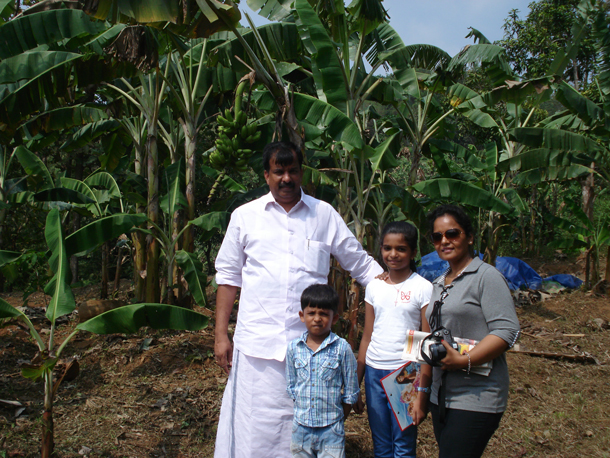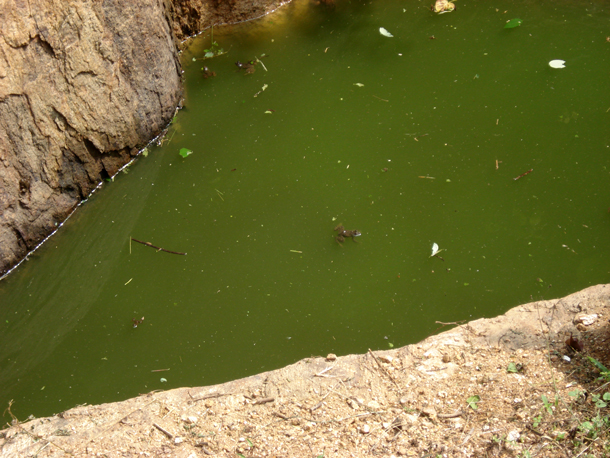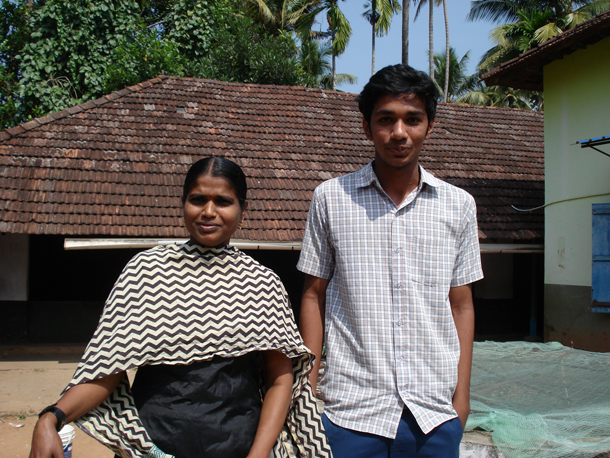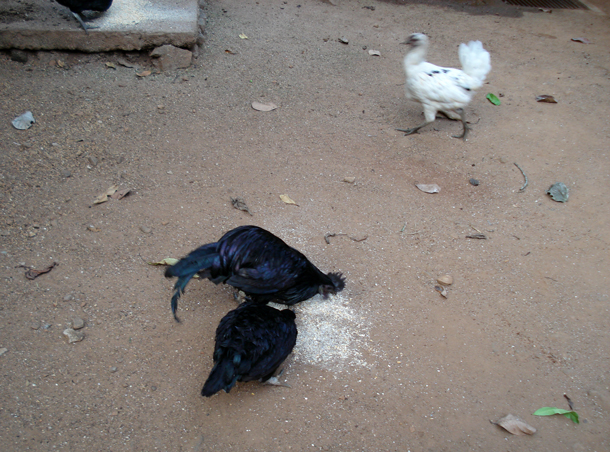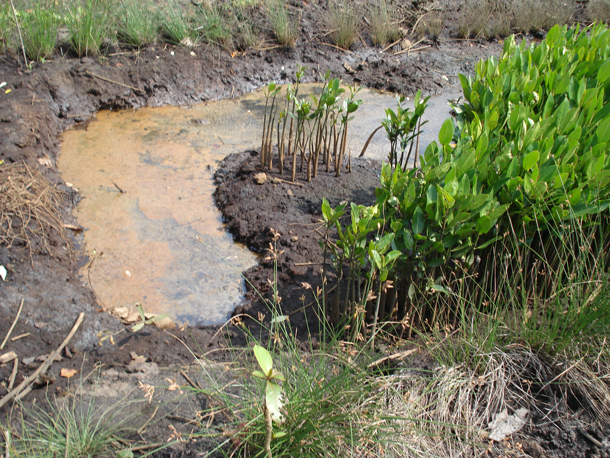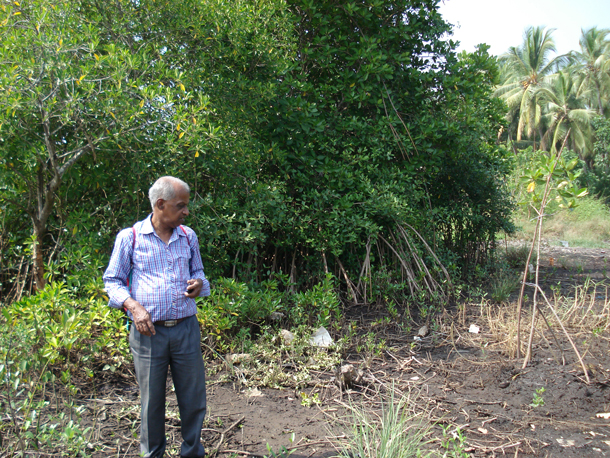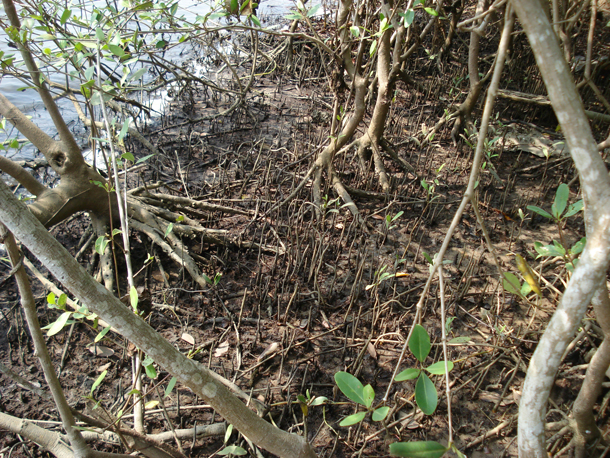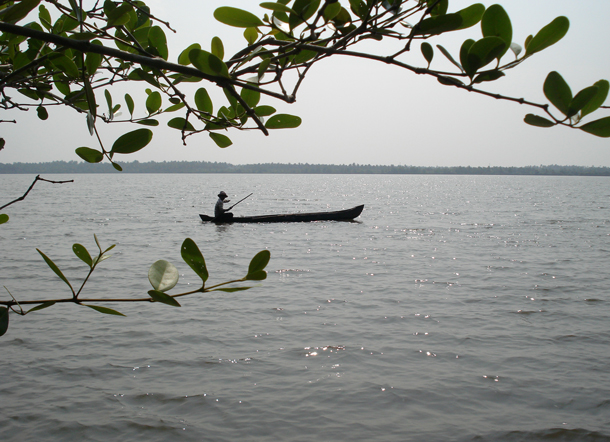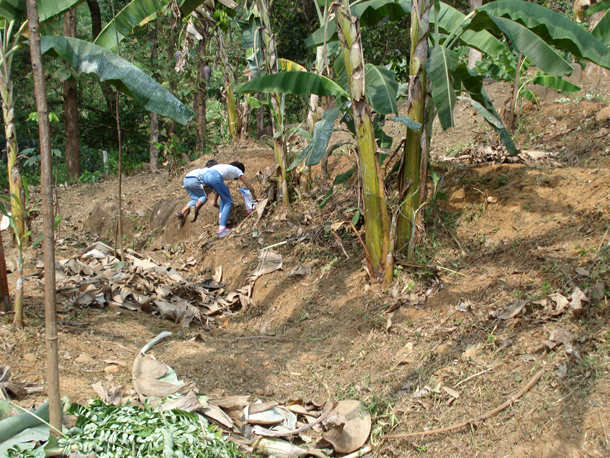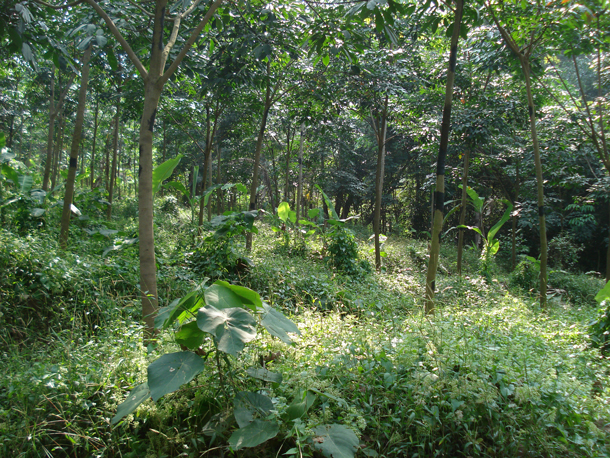Saving Kerala's Fresh Water
Air Date: Week of May 18, 2018
Like much of South Asia, the Indian state of Kerala depends on the prolific monsoon rains for water to drink and grow food. But weak monsoons and recent droughts make water conservation and management vital, so farmers and householders are rediscovering old methods that are yielding new water security. Living on Earth’s Helen Palmer reported.
Transcript
CURWOOD: It’s Living on Earth, I’m Steve Curwood. In South Asia, the monsoons are the key to growing and irrigating crops, and filling wells with drinking water.
Some South Indian states, like Kerala, typically get strong monsoons – as much as ten feet of rain usually falls there every year. But in the last decade the monsoons have become erratic, and there have been some severe droughts - perhaps due to the changing climate and shifting wind patterns. This has led Kerala’s government to declare water conservation a top goal. And as Living on Earth’s Helen Palmer discovered on a visit, reports of the monsoon status can lead the local news.
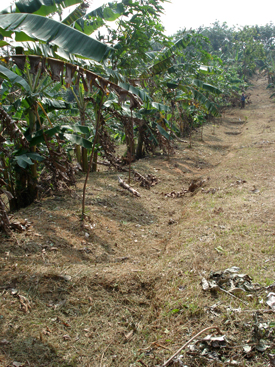
Vargheese Tharakan has dug trenches across his steep hillside plot to retain water for his banana plants. Every 4 or 5 feet along the trench an earthen mound keeps water near the roots. (Photo: Helen Palmer)
[SOUND OF RAIN]
NEWS READER: The Monsoon has finally reached mainland India, with 2 consecutive days of rain in Kerala. But so far it’s been a weak monsoon that missed its expected arrival date and arrived 5 days late, amid fears of drought-like conditions, and an intense heat wave.
[SOUNDS OF WALKING, BIRDS, DISTANT ROOSTERS CROWING]
PALMER: Weak unreliable rains can be a disaster for farmers, but on his plantation in Thrissur where I meet him and his family shortly before the monsoon arrives, Vargheese [vur-gaze] Tharakan has dug trenches across his steep hillside plot to corral the water. Vargheese is tall and broad, in a spotless white shirt and dhoty, the broad length of cotton cloth many Indians wear knotted round the waist. His petite wife Sandhya and children wear western clothes, jeans for 10 year old Varsha and 6 year old Varun and a gray sweater, black pants and big sunglasses for Sandhya. She points up the slope to rows of banana plants, with broad glossy leaves, heavy with green fruit.
SANDHYA: It’s basically a drought affected area, and even though in Kerala we get 3070 mm rain, but here we get much lesser. As you can see it’s a slope kind of geographical pattern, so he has done cross trenching method and each and every drop of water which falls here is trapped and forced under the ground.
PALMER: It’s partly a very old technique to retain rainwater on this steep three and a half acres. Now the slope is lush, with a tangle of grass and creepers among banana plants, and between each row, a trench about two feet deep. Every 4 to 5 feet along the trench, there’s an earthen mound – effectively creating a series of individual water storage pools – though they’re dry now, between the monsoons.
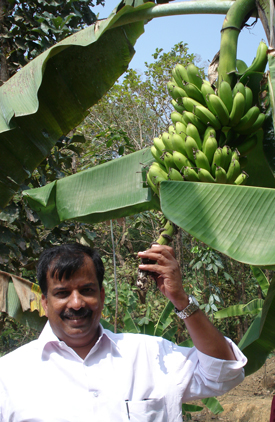
Vargheese Tharakan proudly shows the fruits of his healthy banana trees. (Photo: Helen Palmer)
SANDHYA: And you can see that we have a pond kind of thing here – during this season – like November, December, January and all, it is kind of winter and windy and all. So usually what happens is all the water sources dries up, but you can see it is filled with water still – and we are not watering the plants with any kind of agriculture methods. All these bananas they are standing here, they’re giving fruits entirely on the rain water he has harvested and stored under the earth.
PALMER: We walk over to the pond – it’s deep with near vertical earthen sides and a frog swimming in its murky green water. It’s not only Tharakhan’s own bananas that benefit from this water retention. Rainwater management expert Jos Raphael has watched this farm’s development closely. Jos is serious and intense and like many professional men I met in Kerala, he has a bushy moustache. Holding back the water like this, he says, solves a problem for the community at the bottom of the hill as well.
RAPHAEL: Thirty farmers living in the downhill, they’ve got 10 acres of land together – so these farmers, they had water scarcity for irrigation and for the drinking and the domestic water requirements. Then the government gave a tube well, irrigating these 10 acres of land. It worked almost till 2012 – so ultimately what happened, this tube well gone dried.
PALMER: But then, Jos says, Vargheese Tharakan took over the barren hill plantation above their fields, and dug his transverse trenches that hold back the monsoon rains so they percolate slowly through the earth.
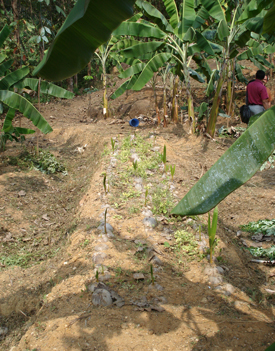
Vargheese Tharakan has planted baby coconut palms on top of the some of the trenches he built. (Photo: Helen Palmer)
RAPHAEL: And this barren hill, he made it as a garden, then the rainwater harvesting with these contour trenches helped the people in the down hill; otherwise this rainwater used to flow down and ultimately to reach the paddy fields and go to the sea, Arabian Sea.
PALMER: We head down the hill to check out the wells of the village at the bottom – and there’s water in their depths as well – and clothes drying on the washing lines by the brightly painted houses.
[TRAFFIC SOUNDS, CAR DOOR SLAMS AND CROWS CALLING]
From the village, Jos Raphael takes me to his home, a simple bungalow where he shows off rainwater conservation for the household. It’s a system of gutters and PVC pipes that feed the well in his garden with a motor to pump water up to the large blue rooftop tank. He says people all used to collect rainwater, much as people round the world do now in barrels for their gardens, but increasing development and urbanization made it obsolete.
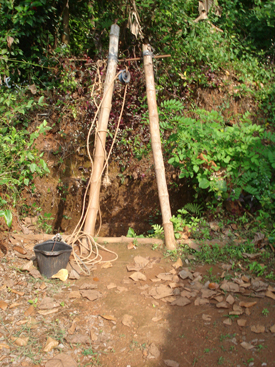
A village well and pulley system for drawing water (Photo: Helen Palmer)
[QUIET OUTDOOR ATMOS, OCCASIONAL BIRDS, WALKING, FROM BIRDS, DISTANT MUSIC]
RAPHAEL: Well in the past history of India, India used to collect rainwater for the domestic use, then what happened, the shift took place in the 1950s, this modernization and piped supply and dams and canal irrigation system. When the people start to get the water in the homesteads, with the piped water supply systems, the people tend to ignore their homestead wells, so the traditional wisdom of harvesting rainwater within the homestead the people tend to forget.
PALMER: And the neglect of the old ways, so now the rainwater just runs off to the sea, isn’t the only water headache for local officials. Deforestation in the once thickly wooded mountainous Western Ghats has reduced the amount of water these western highlands retain, and increased erosion. But Jos Raphael works for a non-profit that got busy.
RAPHAEL: We’ve got a project in Thrissur district administration called Mazhapolima, that means “the bountiful rain”, so we are trying to harvest this rainwater as well as we promote the homestead watershed approaches so that the rainwater in the homestead is conserved.
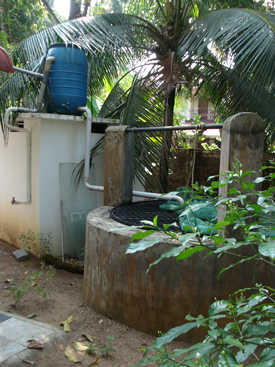
Jos Raphael’s water collection and storage system at his home. (Photo: Helen Palmer)
[SCHOOL – CHATTER OF CHILDREN]
PALMER: We visit one of his projects at a public government high school, where Jos Raphael, smartly dressed in a well pressed green cotton shirt and grey slacks is greeted warmly. His team supplied equipment to collect that bountiful rain for the school. Mini Kollat, a no-nonsense economics teacher in black with a striking geometrically patterned black and white scarf, explains.
KOLLAT: The roof’s water will be collected by the pipes and it will be collected to the wells, to the filter, so that will increase the level of ground water. Water is an elixir of life, because there is no option to water.
PALMER: Mini Kollat’s students helped to put up the gutters and connect the pipes that funnel the water through charcoal filters into the huge well in the school courtyard. That well now supplies all the basic needs of the school. And 18 year old Fabien, tall and gangly in his school uniform check shirt and blue pants, tells me the pupils helped the community around the school as well.

Living on Earth’s Helen Palmer with Jos Raphael, a rainwater conservation expert with the nonprofit Mazhapolima. (Photo: Helen Palmer)
FABIEN: That Mazhapolima scheme was to reduce scarcity of water in that area. In our area there are a lot of poor people so by connecting the pipes, and by using the filter and the motor etc we can give water.
PALMER: Fabien tells me the NGO supplied gutters and pipes and the students helped set them up for their own parents and on the roofs of many manual laborers who live round the school, who don’t have the cash to buy their own system. Jos Raphael says he’s proud of Mazhapolima’s success.
[QUIET OUTDOOR SOUNDS, DISTANT BIRDS AND CRICKETS]
RAPHAEL: We have done more than 25,000 well recharging units in Kerala and with this government subsidy, that will help the people to help recharge their homestead wells, so it has become a role model across the state – so that’s the success of this piloting in Thrissur district. That’s what I’m happy about.
PALMER: But if some townsfolk need a refresher course in traditional methods of managing water, those ways are still widely practiced in the countryside by farmers like Giresha at Wadhikhancheri village, a short drive from the High School down on to the low-lying coastal plain.
[SOUND OF CAR DOOR, CHICKENS CLUCKING, DOGS BARKING]
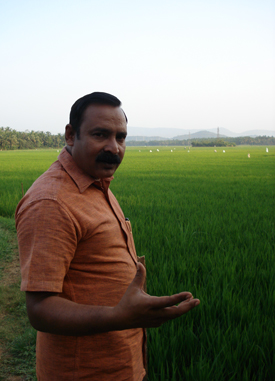
Giresha keeps milk cows and grows rice [shown here] and coconuts at his organic farm at Wadhikhancheri village. (Photo: Helen Palmer)
The guard dogs greet us boisterously at Giresha’s farm. He cultivates six acres of rice and coconuts organically on land his father and grandfather farmed before him. Beside the cowshed, with its dozen indigenous milk cows, Giresha points to a special breed of chicken pecking about in the farmyard.
GIRESHA: We locally call it karingori. It’s completely black – see? everything is black and even the meat is black.
PALMER: Really? Gosh, black chicken!
GIRESHA: And even the bones, internal organs, even the blood.
[HENS CLUCKING]
PALMER: Giresha tells me it’s important to him to preserve these heritage breeds – the chickens as well as the cows. We cross the yard to the cowshed, where one of his workers is hosing down the floor, and he tells me that water drains down to his organic paddy fields – which provide not only rice, but also hay for the cows.

The rice in Giresha’s fields is a brilliant green even during Kerala’s dry season. (Photo: Helen Palmer)
GIRESHA: I feed hay – mainly hay because I got a paddy field, so the hay is here.
PALMER: So basically you get the hay, the rice straw from the paddy field and you feed that to the cow?
GIRESHA: And the cow dung as a fertilizer I am using back to the fields, so I don’t have to purchase fertilizers.
PALMER: As well as the runoff from the cowshed, Giresha uses rainwater during the dry season for irrigation. Some of his fields lie below sea level, he says, and in monsoon season they flood and he can harvest fish. He says it’s vital to maintain the level of fresh water in the paddy to feed the local aquifers and hold back the salt.
[TRAFFIC NOISE AND WATER LAPPING AT COAST]
Rising sea levels are also increasing salinity in fresh water at the coast and percolating into drinking water wells there. On top of that, increasing development, especially for tourism, has led to widespread destruction of one of the main protectors of Kerala’s coastline, the mangrove swamps. That’s a big worry for Ravi Panakhal – whom I meet about five miles from Giresha’s farm at an airy barn on muddy flats by the Arabian Sea shore. Here he teaches school kids about the importance of the mangroves.
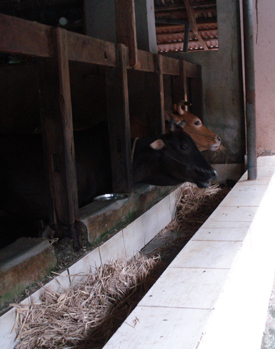
Giresha feeds his indigenous Indian cows hay from his rice paddy fields, and then fertilizes those fields with the manure the cows produce. (Photo: Helen Palmer)
[SOUND OF WATER LAPPING AT SHORE]
PANAKHAL: There were so many mangrove forests in India but during the course of time people for their selfish interests, own interests, they have removed all the mangroves.
PALMER: Panakhal, a trim retired army colonel, heads the NGO Nature, Environment and Wildlife Society of India that gets the local schools involved in replanting the mangroves. Along a series of muddy trenches filled with brackish water, they’ve set out rows of baby mangrove plants, planning to grow them up until they can be planted along the shore for their many benefits.
PANAKHAL: Mangroves cleans the water; besides it is the habitat of a lot of birds, even the migratory birds also. Besides the biodiversity, there are special species of a lot of plants, animals and such things.
PALMER: As well as cleaning up the water, mangroves help prevent erosion, blunt the force of storms and provide a nursery for baby fish.
PANAKHAL: If we keep the mangroves in the belt of this area, the fishing, because actually these people were making livelihood from the fishes, that will improve and the coastal area will be protected and the water will be purified, not salty water, clean water for drinkable water.
PALMER: Protecting species and conserving clean water are a chief aim of the government’s Green Kerala initiative. What Ravi Panakhal wants is a Nature Reserve to do just that on this swampy parcel of coast.
PANAKHAL: This is 234 acres of land is there. What we want, actually we want a protected area, to protect the livelihood of the people and to serve mankind as well as the existing species. It's land for the government but government is not interested in it.
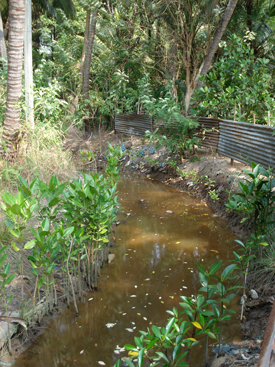
Brackish water ditches lined with baby mangroves that Ravi Panakhal wants to plant along the shore to fight erosion, help clean the water and act as a nursery for fish. (Photo: Helen Palmer)
PALMER: Tourist condos and hotels and restaurants bring in cash to undeveloped areas like this and that’s what appeals to the government and local businesses, Panakhal tells me. But still he says, Nature will have the final say.
PANAKHAL: If we can build a building here and get more money, I will get more money, but this area, it is going to be spoiled and the next generation, that will be suffered. They don’t want to think about the nature, if nature loses, we are going to die. The next generation cannot survive without water, without this nature, it’s very very important, we must keep it up!
[CROSSFADE LAPPING WATER TO SOUNDS OF BIRDS AND CRICKETS]
PALMER: Back at his banana farm in the highlands, Vargheese Tharakan and his family are also keeping Nature up by reforesting, which helps bring rain to these dry hills. Some of the plants stand in the shade of native teak trees that also grow here. Sandhya says they’re planting even more, not to harvest, but for their children, Varsha and Varun, and to retain the water, protect the soil and fight global warming.
PALMER: Sandhya, tell me about the teak.
SANDHYA: It was here when we bought this plot actually – and we don’t have any plans to cut it, because it amounts to deforestation. And you can see it's a slope kind of geography here so it has to be here to hold the soil together and prevent soil erosion.
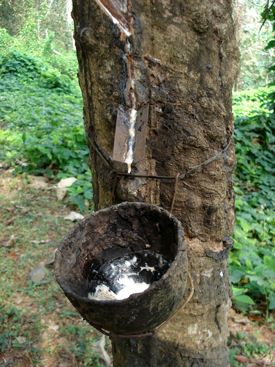
Rubber plantations line the steep hillside where Vergheese Tharakan grows his organic bananas. (Photo: Helen Palmer)
PALMER: So you are planting more?
SANDHYA: Yeah definitely we plant more and definitely it’s a part of reforestation, because we follow here rainwater harvesting and rain can happen only if there is forest.
PALMER: And is this because the government says you have to reforest, or is it something you want to do?
SANDHYA: No, it’s from our kind of ideology we are doing this. We are taking so many things from the Nature, so we should give something back to them, it’s not always taking, giving also is a part of life.
PALMER: The children, 10 year old Varsha and 6 year old Varun scramble up the steep ditches under the trees, and I scramble after – Varsha tells me she’s already trying to give back to the family.
VARSHA: I wanted to grow many things but I thought about starting off small by growing some bean plants. So I planted them maybe 3 or 4 months ago and now they have grown a lot and now they are giving of beans and we are already plucking a few of them and using it for our curries and all.
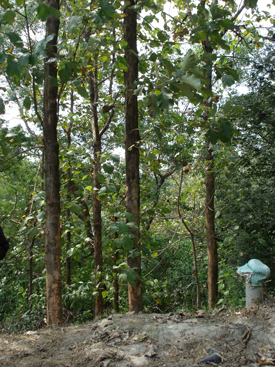
Sandhya Tharakan says it’s important to her and her husband Vargheese to reforest their land with teak trees; they help hold the soil together, and she wants to give back to nature. (Photo: Helen Palmer)
PALMER: So basically you are growing beans that the family can eat?
VARSHA. Yeah.
PALMER: Vargheese, her father smiles at her proudly – he says growing things is
nothing less than the key to the future. He grabs my hand urgently and struggles with English as he tries to get his big idea across, that children everywhere should learn farming.
THARAKAN: Peaceful world. Standard studying agriculture, one subject compulsory all over world – after then – peaceful world.
PALMER: Sandhya helps him out.
SANDHYA: So what he ultimately aims is world peace – through agriculture, through cultivation, through farming.
PALMER: World peace though tending the land - it’s a grand dream, but in their small plot of paradise, the Tharakan family is doing its bit, growing bananas and vegetables, restoring the soil, bringing back the trees and saving the rain.
For Living on Earth, I’m Helen Palmer in Kerala, India.
Links
The Mazhapolima rain conservation project
The Nature, Environment & Wildlife Society
Journal article: “Effect of climate change on seasonal monsoon in Asia”
United Nations webpage on rain harvesting in Kerala
India Climate Dialogue: “W(h)ither Kerala’s mangroves”
IndiaTimes blog: “Why India needs protection from unreliable monsoons”
Listen to our first story in the series: “Kerala’s Ambitious Organic Pledge"
The second story in the series: “Pesticide Peril in Paradise”
Living on Earth wants to hear from you!
Living on Earth
62 Calef Highway, Suite 212
Lee, NH 03861
Telephone: 617-287-4121
E-mail: comments@loe.org
Newsletter [Click here]
Donate to Living on Earth!
Living on Earth is an independent media program and relies entirely on contributions from listeners and institutions supporting public service. Please donate now to preserve an independent environmental voice.
NewsletterLiving on Earth offers a weekly delivery of the show's rundown to your mailbox. Sign up for our newsletter today!
 Sailors For The Sea: Be the change you want to sea.
Sailors For The Sea: Be the change you want to sea.
 The Grantham Foundation for the Protection of the Environment: Committed to protecting and improving the health of the global environment.
The Grantham Foundation for the Protection of the Environment: Committed to protecting and improving the health of the global environment.
 Contribute to Living on Earth and receive, as our gift to you, an archival print of one of Mark Seth Lender's extraordinary wildlife photographs. Follow the link to see Mark's current collection of photographs.
Contribute to Living on Earth and receive, as our gift to you, an archival print of one of Mark Seth Lender's extraordinary wildlife photographs. Follow the link to see Mark's current collection of photographs.
 Buy a signed copy of Mark Seth Lender's book Smeagull the Seagull & support Living on Earth
Buy a signed copy of Mark Seth Lender's book Smeagull the Seagull & support Living on Earth
Like much of South Asia, the Indian state of Kerala depends on the prolific monsoon rains for water to drink and grow food. But weak monsoons and recent droughts make water conservation and management vital, so farmers and householders are rediscovering old methods that are yielding new water security. Living on Earth’s Helen Palmer reported.
Transcript
CURWOOD: It’s Living on Earth, I’m Steve Curwood. In South Asia, the monsoons are the key to growing and irrigating crops, and filling wells with drinking water.
Some South Indian states, like Kerala, typically get strong monsoons – as much as ten feet of rain usually falls there every year. But in the last decade the monsoons have become erratic, and there have been some severe droughts - perhaps due to the changing climate and shifting wind patterns. This has led Kerala’s government to declare water conservation a top goal. And as Living on Earth’s Helen Palmer discovered on a visit, reports of the monsoon status can lead the local news.

Vargheese Tharakan has dug trenches across his steep hillside plot to retain water for his banana plants. Every 4 or 5 feet along the trench an earthen mound keeps water near the roots. (Photo: Helen Palmer)
[SOUND OF RAIN]
NEWS READER: The Monsoon has finally reached mainland India, with 2 consecutive days of rain in Kerala. But so far it’s been a weak monsoon that missed its expected arrival date and arrived 5 days late, amid fears of drought-like conditions, and an intense heat wave.
[SOUNDS OF WALKING, BIRDS, DISTANT ROOSTERS CROWING]
PALMER: Weak unreliable rains can be a disaster for farmers, but on his plantation in Thrissur where I meet him and his family shortly before the monsoon arrives, Vargheese [vur-gaze] Tharakan has dug trenches across his steep hillside plot to corral the water. Vargheese is tall and broad, in a spotless white shirt and dhoty, the broad length of cotton cloth many Indians wear knotted round the waist. His petite wife Sandhya and children wear western clothes, jeans for 10 year old Varsha and 6 year old Varun and a gray sweater, black pants and big sunglasses for Sandhya. She points up the slope to rows of banana plants, with broad glossy leaves, heavy with green fruit.
SANDHYA: It’s basically a drought affected area, and even though in Kerala we get 3070 mm rain, but here we get much lesser. As you can see it’s a slope kind of geographical pattern, so he has done cross trenching method and each and every drop of water which falls here is trapped and forced under the ground.
PALMER: It’s partly a very old technique to retain rainwater on this steep three and a half acres. Now the slope is lush, with a tangle of grass and creepers among banana plants, and between each row, a trench about two feet deep. Every 4 to 5 feet along the trench, there’s an earthen mound – effectively creating a series of individual water storage pools – though they’re dry now, between the monsoons.

Vargheese Tharakan proudly shows the fruits of his healthy banana trees. (Photo: Helen Palmer)
SANDHYA: And you can see that we have a pond kind of thing here – during this season – like November, December, January and all, it is kind of winter and windy and all. So usually what happens is all the water sources dries up, but you can see it is filled with water still – and we are not watering the plants with any kind of agriculture methods. All these bananas they are standing here, they’re giving fruits entirely on the rain water he has harvested and stored under the earth.
PALMER: We walk over to the pond – it’s deep with near vertical earthen sides and a frog swimming in its murky green water. It’s not only Tharakhan’s own bananas that benefit from this water retention. Rainwater management expert Jos Raphael has watched this farm’s development closely. Jos is serious and intense and like many professional men I met in Kerala, he has a bushy moustache. Holding back the water like this, he says, solves a problem for the community at the bottom of the hill as well.
RAPHAEL: Thirty farmers living in the downhill, they’ve got 10 acres of land together – so these farmers, they had water scarcity for irrigation and for the drinking and the domestic water requirements. Then the government gave a tube well, irrigating these 10 acres of land. It worked almost till 2012 – so ultimately what happened, this tube well gone dried.
PALMER: But then, Jos says, Vargheese Tharakan took over the barren hill plantation above their fields, and dug his transverse trenches that hold back the monsoon rains so they percolate slowly through the earth.

Vargheese Tharakan has planted baby coconut palms on top of the some of the trenches he built. (Photo: Helen Palmer)
RAPHAEL: And this barren hill, he made it as a garden, then the rainwater harvesting with these contour trenches helped the people in the down hill; otherwise this rainwater used to flow down and ultimately to reach the paddy fields and go to the sea, Arabian Sea.
PALMER: We head down the hill to check out the wells of the village at the bottom – and there’s water in their depths as well – and clothes drying on the washing lines by the brightly painted houses.
[TRAFFIC SOUNDS, CAR DOOR SLAMS AND CROWS CALLING]
From the village, Jos Raphael takes me to his home, a simple bungalow where he shows off rainwater conservation for the household. It’s a system of gutters and PVC pipes that feed the well in his garden with a motor to pump water up to the large blue rooftop tank. He says people all used to collect rainwater, much as people round the world do now in barrels for their gardens, but increasing development and urbanization made it obsolete.

A village well and pulley system for drawing water (Photo: Helen Palmer)
[QUIET OUTDOOR ATMOS, OCCASIONAL BIRDS, WALKING, FROM BIRDS, DISTANT MUSIC]
RAPHAEL: Well in the past history of India, India used to collect rainwater for the domestic use, then what happened, the shift took place in the 1950s, this modernization and piped supply and dams and canal irrigation system. When the people start to get the water in the homesteads, with the piped water supply systems, the people tend to ignore their homestead wells, so the traditional wisdom of harvesting rainwater within the homestead the people tend to forget.
PALMER: And the neglect of the old ways, so now the rainwater just runs off to the sea, isn’t the only water headache for local officials. Deforestation in the once thickly wooded mountainous Western Ghats has reduced the amount of water these western highlands retain, and increased erosion. But Jos Raphael works for a non-profit that got busy.
RAPHAEL: We’ve got a project in Thrissur district administration called Mazhapolima, that means “the bountiful rain”, so we are trying to harvest this rainwater as well as we promote the homestead watershed approaches so that the rainwater in the homestead is conserved.

Jos Raphael’s water collection and storage system at his home. (Photo: Helen Palmer)
[SCHOOL – CHATTER OF CHILDREN]
PALMER: We visit one of his projects at a public government high school, where Jos Raphael, smartly dressed in a well pressed green cotton shirt and grey slacks is greeted warmly. His team supplied equipment to collect that bountiful rain for the school. Mini Kollat, a no-nonsense economics teacher in black with a striking geometrically patterned black and white scarf, explains.
KOLLAT: The roof’s water will be collected by the pipes and it will be collected to the wells, to the filter, so that will increase the level of ground water. Water is an elixir of life, because there is no option to water.
PALMER: Mini Kollat’s students helped to put up the gutters and connect the pipes that funnel the water through charcoal filters into the huge well in the school courtyard. That well now supplies all the basic needs of the school. And 18 year old Fabien, tall and gangly in his school uniform check shirt and blue pants, tells me the pupils helped the community around the school as well.

Living on Earth’s Helen Palmer with Jos Raphael, a rainwater conservation expert with the nonprofit Mazhapolima. (Photo: Helen Palmer)
FABIEN: That Mazhapolima scheme was to reduce scarcity of water in that area. In our area there are a lot of poor people so by connecting the pipes, and by using the filter and the motor etc we can give water.
PALMER: Fabien tells me the NGO supplied gutters and pipes and the students helped set them up for their own parents and on the roofs of many manual laborers who live round the school, who don’t have the cash to buy their own system. Jos Raphael says he’s proud of Mazhapolima’s success.
[QUIET OUTDOOR SOUNDS, DISTANT BIRDS AND CRICKETS]
RAPHAEL: We have done more than 25,000 well recharging units in Kerala and with this government subsidy, that will help the people to help recharge their homestead wells, so it has become a role model across the state – so that’s the success of this piloting in Thrissur district. That’s what I’m happy about.
PALMER: But if some townsfolk need a refresher course in traditional methods of managing water, those ways are still widely practiced in the countryside by farmers like Giresha at Wadhikhancheri village, a short drive from the High School down on to the low-lying coastal plain.
[SOUND OF CAR DOOR, CHICKENS CLUCKING, DOGS BARKING]

Giresha keeps milk cows and grows rice [shown here] and coconuts at his organic farm at Wadhikhancheri village. (Photo: Helen Palmer)
The guard dogs greet us boisterously at Giresha’s farm. He cultivates six acres of rice and coconuts organically on land his father and grandfather farmed before him. Beside the cowshed, with its dozen indigenous milk cows, Giresha points to a special breed of chicken pecking about in the farmyard.
GIRESHA: We locally call it karingori. It’s completely black – see? everything is black and even the meat is black.
PALMER: Really? Gosh, black chicken!
GIRESHA: And even the bones, internal organs, even the blood.
[HENS CLUCKING]
PALMER: Giresha tells me it’s important to him to preserve these heritage breeds – the chickens as well as the cows. We cross the yard to the cowshed, where one of his workers is hosing down the floor, and he tells me that water drains down to his organic paddy fields – which provide not only rice, but also hay for the cows.

The rice in Giresha’s fields is a brilliant green even during Kerala’s dry season. (Photo: Helen Palmer)
GIRESHA: I feed hay – mainly hay because I got a paddy field, so the hay is here.
PALMER: So basically you get the hay, the rice straw from the paddy field and you feed that to the cow?
GIRESHA: And the cow dung as a fertilizer I am using back to the fields, so I don’t have to purchase fertilizers.
PALMER: As well as the runoff from the cowshed, Giresha uses rainwater during the dry season for irrigation. Some of his fields lie below sea level, he says, and in monsoon season they flood and he can harvest fish. He says it’s vital to maintain the level of fresh water in the paddy to feed the local aquifers and hold back the salt.
[TRAFFIC NOISE AND WATER LAPPING AT COAST]
Rising sea levels are also increasing salinity in fresh water at the coast and percolating into drinking water wells there. On top of that, increasing development, especially for tourism, has led to widespread destruction of one of the main protectors of Kerala’s coastline, the mangrove swamps. That’s a big worry for Ravi Panakhal – whom I meet about five miles from Giresha’s farm at an airy barn on muddy flats by the Arabian Sea shore. Here he teaches school kids about the importance of the mangroves.

Giresha feeds his indigenous Indian cows hay from his rice paddy fields, and then fertilizes those fields with the manure the cows produce. (Photo: Helen Palmer)
[SOUND OF WATER LAPPING AT SHORE]
PANAKHAL: There were so many mangrove forests in India but during the course of time people for their selfish interests, own interests, they have removed all the mangroves.
PALMER: Panakhal, a trim retired army colonel, heads the NGO Nature, Environment and Wildlife Society of India that gets the local schools involved in replanting the mangroves. Along a series of muddy trenches filled with brackish water, they’ve set out rows of baby mangrove plants, planning to grow them up until they can be planted along the shore for their many benefits.
PANAKHAL: Mangroves cleans the water; besides it is the habitat of a lot of birds, even the migratory birds also. Besides the biodiversity, there are special species of a lot of plants, animals and such things.
PALMER: As well as cleaning up the water, mangroves help prevent erosion, blunt the force of storms and provide a nursery for baby fish.
PANAKHAL: If we keep the mangroves in the belt of this area, the fishing, because actually these people were making livelihood from the fishes, that will improve and the coastal area will be protected and the water will be purified, not salty water, clean water for drinkable water.
PALMER: Protecting species and conserving clean water are a chief aim of the government’s Green Kerala initiative. What Ravi Panakhal wants is a Nature Reserve to do just that on this swampy parcel of coast.
PANAKHAL: This is 234 acres of land is there. What we want, actually we want a protected area, to protect the livelihood of the people and to serve mankind as well as the existing species. It's land for the government but government is not interested in it.

Brackish water ditches lined with baby mangroves that Ravi Panakhal wants to plant along the shore to fight erosion, help clean the water and act as a nursery for fish. (Photo: Helen Palmer)
PALMER: Tourist condos and hotels and restaurants bring in cash to undeveloped areas like this and that’s what appeals to the government and local businesses, Panakhal tells me. But still he says, Nature will have the final say.
PANAKHAL: If we can build a building here and get more money, I will get more money, but this area, it is going to be spoiled and the next generation, that will be suffered. They don’t want to think about the nature, if nature loses, we are going to die. The next generation cannot survive without water, without this nature, it’s very very important, we must keep it up!
[CROSSFADE LAPPING WATER TO SOUNDS OF BIRDS AND CRICKETS]
PALMER: Back at his banana farm in the highlands, Vargheese Tharakan and his family are also keeping Nature up by reforesting, which helps bring rain to these dry hills. Some of the plants stand in the shade of native teak trees that also grow here. Sandhya says they’re planting even more, not to harvest, but for their children, Varsha and Varun, and to retain the water, protect the soil and fight global warming.
PALMER: Sandhya, tell me about the teak.
SANDHYA: It was here when we bought this plot actually – and we don’t have any plans to cut it, because it amounts to deforestation. And you can see it's a slope kind of geography here so it has to be here to hold the soil together and prevent soil erosion.

Rubber plantations line the steep hillside where Vergheese Tharakan grows his organic bananas. (Photo: Helen Palmer)
PALMER: So you are planting more?
SANDHYA: Yeah definitely we plant more and definitely it’s a part of reforestation, because we follow here rainwater harvesting and rain can happen only if there is forest.
PALMER: And is this because the government says you have to reforest, or is it something you want to do?
SANDHYA: No, it’s from our kind of ideology we are doing this. We are taking so many things from the Nature, so we should give something back to them, it’s not always taking, giving also is a part of life.
PALMER: The children, 10 year old Varsha and 6 year old Varun scramble up the steep ditches under the trees, and I scramble after – Varsha tells me she’s already trying to give back to the family.
VARSHA: I wanted to grow many things but I thought about starting off small by growing some bean plants. So I planted them maybe 3 or 4 months ago and now they have grown a lot and now they are giving of beans and we are already plucking a few of them and using it for our curries and all.

Sandhya Tharakan says it’s important to her and her husband Vargheese to reforest their land with teak trees; they help hold the soil together, and she wants to give back to nature. (Photo: Helen Palmer)
PALMER: So basically you are growing beans that the family can eat?
VARSHA. Yeah.
PALMER: Vargheese, her father smiles at her proudly – he says growing things is
nothing less than the key to the future. He grabs my hand urgently and struggles with English as he tries to get his big idea across, that children everywhere should learn farming.
THARAKAN: Peaceful world. Standard studying agriculture, one subject compulsory all over world – after then – peaceful world.
PALMER: Sandhya helps him out.
SANDHYA: So what he ultimately aims is world peace – through agriculture, through cultivation, through farming.
PALMER: World peace though tending the land - it’s a grand dream, but in their small plot of paradise, the Tharakan family is doing its bit, growing bananas and vegetables, restoring the soil, bringing back the trees and saving the rain.
For Living on Earth, I’m Helen Palmer in Kerala, India.
Links
The Mazhapolima rain conservation project
The Nature, Environment & Wildlife Society
Journal article: “Effect of climate change on seasonal monsoon in Asia”
United Nations webpage on rain harvesting in Kerala
India Climate Dialogue: “W(h)ither Kerala’s mangroves”
IndiaTimes blog: “Why India needs protection from unreliable monsoons”
Listen to our first story in the series: “Kerala’s Ambitious Organic Pledge"
The second story in the series: “Pesticide Peril in Paradise”
Living on Earth wants to hear from you!
Living on Earth
62 Calef Highway, Suite 212
Lee, NH 03861
Telephone: 617-287-4121
E-mail: comments@loe.org
Newsletter [Click here]
Donate to Living on Earth!
Living on Earth is an independent media program and relies entirely on contributions from listeners and institutions supporting public service. Please donate now to preserve an independent environmental voice.
NewsletterLiving on Earth offers a weekly delivery of the show's rundown to your mailbox. Sign up for our newsletter today!
 Sailors For The Sea: Be the change you want to sea.
Sailors For The Sea: Be the change you want to sea.
 The Grantham Foundation for the Protection of the Environment: Committed to protecting and improving the health of the global environment.
The Grantham Foundation for the Protection of the Environment: Committed to protecting and improving the health of the global environment.
 Contribute to Living on Earth and receive, as our gift to you, an archival print of one of Mark Seth Lender's extraordinary wildlife photographs. Follow the link to see Mark's current collection of photographs.
Contribute to Living on Earth and receive, as our gift to you, an archival print of one of Mark Seth Lender's extraordinary wildlife photographs. Follow the link to see Mark's current collection of photographs.
 Buy a signed copy of Mark Seth Lender's book Smeagull the Seagull & support Living on Earth
Buy a signed copy of Mark Seth Lender's book Smeagull the Seagull & support Living on Earth


